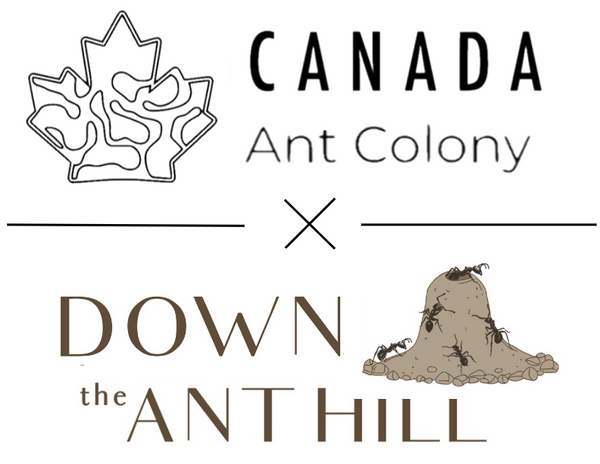
If you'd like to support this blog and are interested in ant supplies, check out https://canada-ant-colony.com for all your ant needs (if you're in Canada) or https://statesideants.com (if you're in the US). You can use the code DTAHAFFIL for 10% off.
Starting a new ant colony can feel overwhelming with the abundance of information online. Wouldn’t it be great to have an experienced ant keeper guide you step-by-step? Follow along as we share the best practices for setting up the perfect habitat for your new ant colony. While some of these steps might seem overly detailed, they are crucial to avoid the common mistakes beginners often face. After years of working with ant enthusiasts, we've learned that success in the early stages is key to ensuring people stick with the hobby. The more errors made, the higher the chances of losing interest in ant keeping altogether.
How Long Should You Wait Before Adding Ants to a New Setup?
Preparing your ant habitat can takes just a few hours, depending on gathering the right materials, setting up the formicarium, and allowing the environment to stabilize. Don’t rush this process by impulsively buying ants before doing your research.
1. How Much Should It Cost to Set Up an Ant Farm?
Setting up an ant farm can be a relatively affordable hobby, with initial costs varying depending on the quality of materials and the size of the colony. Here's a breakdown of potential expenses:
- Basic setup cost: $70 - $150 (CAD), or $50 - $100 (USD)
- High-quality or custom setups: $150 - $250 (CAD), or $100 - $175 (USD)
- Ongoing maintenance: Around $2-5 /month for food and supplies
Budget-conscious hobbyists can keep costs lower by starting with DIY formicariums or simple setups, such as a
test tube outworld while more advanced options like professionally-made acrylic or plaster
nests will increase expenses.
Alternatively, all-inclusive ant-keeping kits are also commercially
available.
Esthetic Ant nest with Carpenter Ant Colony
2. Shopping List: What to Prepare for Your Ant Colony
Before setting up your ant farm, gather the essential supplies to ensure your colony's needs are met.
Basic Essentials:
-
Formicarium (Ant Nest): Provides a secure environment for the colony. Options include acrylic, plaster, glass, or DIY options.
-
Outworld (Foraging Area): A separate space for ants to explore, forage, and dispose of waste. Most ant nests will also include an outworld.
-
Connecting Tubing: Clear vinyl tubing to connect the formicarium to the outworld. This is typically included for free in the purchase of most ant nests and most outworlds.
- Feeding Supplies:
- Protein Sources: Insects like mealworms, crickets, or fruit flies (frozen if collected from outside).
- Water Source: Test tubes with cotton plugs or
liquid feeders to prevent drowning.
- Hibernation Setup: For temperate species, a place with 5-12°C (41-53°F) temperatures during winter. This can be a fridge, garage, or a wine cooler
Optional Supplies:
- Barriers to Prevent Escapes:
Fluon/Insect-a-slip is best, but olive oil, talcum powder, may work
- Monitoring Tools: Thermometers and hygrometers for tracking temperature and humidity.
-
Tweezers and Brushes: Useful for moving small objects or cleaning the outworld.
Red Field Ant (Formica subintegra) colony by Ankrauser
3. How to Set Up a Formicarium for Beginners
Follow these steps to create a safe and suitable environment for your ant colony:
Step 1: Choose a Formicarium
- Type of Formicarium: Acrylic, plaster, glass, or DIY options are available. Beginners may find plaster nests easiest to manage because they are transparent and require minimal maintenance.
- Size Consideration: Start small to avoid overwhelming the colony. A formicarium with 2-4 chambers is suitable for young colonies (fewer than 50 workers). The colony should not cover less than 20% of the nest.
Step 2: Set Up the Outworld
- Select a Suitable Container: Choose a container large enough to access for feeding and cleaning, such as a plastic box or glass tank.
- Add a Barrier to Prevent Escapes: Apply fluon, olive oil, or talcum powder, or to the rim of the container.
- Connect the Formicarium and Outworld: Use vinyl tubing to connect them. Ensure all connections are secure.
Step 3: Create a Heat Gradient
- Position the Heating Cable/Mat: Place it under one side of the formicarium to allow the ants to choose their preferred temperature.
Step 4: Add Water to the Formicarium
- Moisten the Nest Regularly: Water the formicarium every 3-14 days to maintain the humidity levels needed for the brood. This depends on your specific nest and the conditions of your room. However, the nest should always have water available.
- Use Test Tubes or Liquid Feeders for Watering: Test tubes with a cotton plug are a popular choice for providing water without risking drowning.
Step 5: Introduce the Ants
- Move the Queen and Workers into the Formicarium: Carefully introduce them to the nest using a test tube setup. This can either be done by dumping the colony into the outworld, or alternatively, simply giving them access to the new nest via the outworld or through tubing. You can expedite a "natural move" by shining a bright light on the setup from which you want the ants to leave.
- Observe Their Behavior: Watch as the colony begins to explore and settle in.
Step 6: Start Feeding
- Offer Sugars and Protein: Begin with a small amount of honey water or fruit juice for sugars, and a piece of a dead insect for protein.
- Adjust Feeding as Needed: Increase the food quantity as the colony grows, ensuring they always have access to fresh food and water.
By following this checklist, you'll have all the basics covered to start your ant farm with confidence. Once your ants settle in, you can expand their habitat, introduce new feeding options, and explore more advanced aspects of ant keeping.

Western Harvester Ants (Pogonomyrmex occidentalis) eating a beheaded cricket




